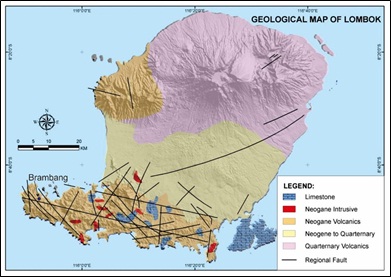Geology, Rock Geochemistry and Ore Fluid Characteristics of the Brambang Copper-Gold Porphyry Prospect, Lombok Island, Indonesia.
DOI:
https://doi.org/10.25299/jgeet.2021.6.1.6145Keywords:
Porphyry Cu-Au, Brambang, Lombok, IndonesiaAbstract
Brambang is one of the porphyry copper-gold prospects/deposits situated along eastern Sunda arc. This study is aimed to understand geological framework, alteration geochemistry and ore fluid characteristics of the prospect. Fieldworks and various laboratory analyses were performed including petrography, ore microscopy, rock geochemistry, chlorite chemistry and fluid inclusion microthermometry. The prospect is composed of andesitic tuff and diorite which are intruded by tonalite porphyries. Tonalite porphyries are interpreted as ore mineralisation-bearing intrusion. Various hydrothermal alterations are identified including potassic, phyllic, propylitic, advanced argillic and argillic types. Ore mineralisation is characterized by magnetite and copper sulfides such as bornite and chalcopyrite. Potassic alteration is typified by secondary biotite, and associated with ore mineralisation. Mass balance calculation indicates SiO2, Fe2O3, K2O, Cu and Au are added during potassic alteration process. Ore forming fluid is dominated by magmatic fluid at high temperature (450-600ºC) and high salinity (60-70 wt. % NaCl eq.). Hydrothermal fluid was diluted by meteoric water incursion at low-moderate temperature of 150-400ºC and salinity of 0.5-7 wt. % NaCl eq.
Downloads
References
Carlile, J.C., Mitchell, A.H.G., 1994. Magmatic arcs and associated gold and copper mineralization in Indonesia. J. Geochem. 50, 91–142.
Cathelineau, M., 1988. Cation Site Occupancy in Chlorite and Illites as a Function of Temperature. Mineral. Soc. 471–485.
Garwin, S., 2002. The Geologic Setting of Intrussio-related Hydrothermal Systems Near The Batu HIjau Porphyry Copper-Gold Deposit, Sumbawa, Indonesia. Soc. Econ. Geol. 333–366.
Grant, J.A., 1986. The isocon diagram-a simple solution to Gresens’ equation for metasomatic alteration. Econ. Geol. 81, 1976–1982.
Gresens, R.L., 1967. Composition-volume relationships of metasomatism. Chem. Geol. 2.
Gustafson, L., Hunt, J., 1975. The porphyry copper deposit at El Salvador, Chile. Econ. Geol. 857–912.
Hall, R., 2012. Tectonophysics Late Jurassic – Cenozoic reconstructions of the Indonesian region and the Indian Ocean. Tectonophysics 570–571, 1–41.
Harrison, R.L., Maryono, A., Cooke, D.R., Rompo, I., Hoschke, T.G., 2018. Tectonics and geology of porphyry Cu-Au deposits along the eastern Sunda magmatic arc, Indonesia. Econ. Geol. 113, 7–38.
Hellman, P.L., 2010. Tujuh Bukit Project Report on Mineral Resources, Located in East Java, Indonesia. Tech. Rep. Interprid Mines Limited.
Hezarkhani, A., 2002. Mass changes during hydrothermal alteration/mineralisation in a porphyry copper deposit, eastern Sungun, northwestern Iran . J. Asian Erath Sci. 20, 567–588.
Idrus, A., Jochen, K., Michael, F.M., 2007. Chemical Composition of Rock-Forming Minerals in Copper – Gold-Bearing Tonalite Porphyries at the Batu Hijau Deposit , Sumbawa Island , Indonesia : Implications for Crystallization Conditions and Fluorine – Chlorine Fugacity 57, 102–113.
Idrus, A., Kolb, J., Meyer, F.M., 2009. Mineralogy, lithogeochemistry and elemental mass balance of the hydrothermal alteration associated with the gold-rich Batu Hijau porphyry copper deposit, Sumbawa Island, Indonesia. Resour. Geol. 59, 215–230.
Mangga, S.A., Atmawinata, S., Hermanto, B., Setyogroho, B., Amin, T., 1994. Peta Geologi Lembar Sumbawa, Nusa Tenggara Barat. Bandung, Indonesia.
Nash, J.T., 1976. Data from PorpHyry Copper Deposits and Applications to Exploration: Reston, VA, United States, U. S. Geological Survey D1–D16.
Pearce, J., Wyman, D., 1996. A users guide to basalt discrimination diagrams, Trace Element
Geochemistry of Volcanic Rocks: Applications for Massive Sulphide Exploration. Geol. Assoc. Canada, Short Course Notes 12, (pg. 79-113).
Peccerillo, A., Taylor, S.R., 1976. Geochemistry of eocene calc-alkaline volcanic rocks from the Kastamonu area, northern Turkey. Contrib. to Mineral. Petrol. 58, 63–81.
Rollinson, H.R., 1993. Using Geochemical Data: Evaluation, Presentation, Interpretation.
Rompo, I., Rowe, A., Maryono, A., 2012. Porphyry Cu-Au and EpithermalAu-Ag Mineralization Systems in South West Lombok.
Setijadji, L.D., Maryono, A., 2012. Geology and Arc Magmatism of the Eastern Sunda Arc , Indonesia.
Ulrich, T., Heinrich, C.A., 2001. Geology and alteration geochemistry of the porphyry Cu-Au deposit at Bajo de la Alumbrera, Argentina. Econ. Geol. 96, 1719–1742.
Wilson, M., 1989. Igneous Petrogenesis, Unwin Hyman, London.
Winchester, J.A., Floyd, P.A., 1976. Geochemical Discrimination of Different Magma Series and their Differentiation Products Using Immobile Elements 20, 325–343

Downloads
Published
Issue
Section
License
Copyright @2019. This is an open-access article distributed under the terms of the Creative Commons Attribution-ShareAlike 4.0 International License which permits unrestricted use, distribution, and reproduction in any medium. Copyrights of all materials published in JGEET are freely available without charge to users or / institution. Users are allowed to read, download, copy, distribute, search, or link to full-text articles in this journal without asking by giving appropriate credit, provide a link to the license, and indicate if changes were made. All of the remix, transform, or build upon the material must distribute the contributions under the same license as the original.










